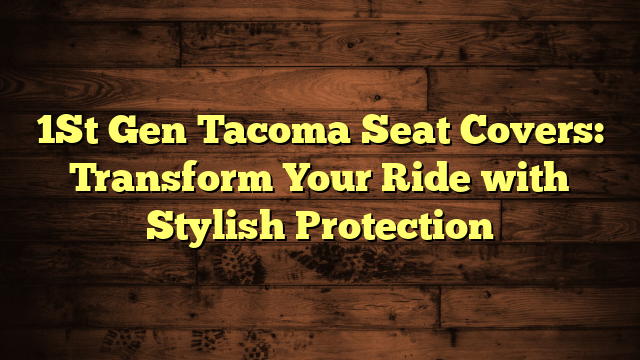What Kind of Seat Covers Do You Put on Leather Seats?
Seat covers for leather seats should be made of materials like neoprene, microfiber, or leatherette to protect the seats from damage while maintaining their luxurious appearance. Neoprene seat covers offer excellent protection against spills, stains, and scratches, and are easy to install and clean.
Microfiber seat covers are soft and durable, providing both comfort and protection. Leatherette seat covers are a popular choice as they mimic the look and feel of real leather while offering easy maintenance and durability. These seat cover options not only safeguard the leather seats but also enhance the overall aesthetics of the vehicle’s interior.
Basics Of Leather Seat Protection
Leather seats can add a touch of luxury to any vehicle. To keep them looking their best, it’s essential to protect them from wear and tear. But why protect leather car seats in the first place? Leather is a natural material that is prone to drying, cracking, and fading over time. Regular exposure to sunlight, heat, and spills can accelerate this process. By using seat covers, you can minimize the damage caused by these factors and extend the lifespan of your leather seats.
| Material | Advantages | Disadvantages |
|---|---|---|
| Neoprene | Durable and waterproof Provides insulation Easy to clean |
May fade or crack over time Can be expensive |
| Leatherette | Highly durable and water-resistant Resembles real leather Easy to maintain |
Can get hot in direct sunlight May not have the same luxury feel as genuine leather |
| Velour | Soft and comfortable Breathable fabric Affordable option |
Not as durable as other materials May not provide full waterproof protection |
Note: These are just a few examples and there are many other seat cover materials available on the market to suit different needs and preferences.
When it comes to choosing seat covers for leather seats, it’s important to consider your personal style, budget, and specific requirements. Whether you opt for neoprene, leatherette, velour, or any other material, remember to regularly clean and condition your leather seats to maintain their appearance and longevity. By selecting the right seat covers and practicing proper maintenance, you can protect your leather seats and enjoy their luxurious feel for years to come.
Finding Your Ideal Seat Covers
Get the perfect seat covers for your leather seats with our guide. Discover the ideal options that provide protection, style, and durability without compromising on comfort.
| Finding Your Ideal Seat Covers | |
| Assessing your needs and lifestyle | |
| When choosing seat covers for your leather seats, it’s important to assess your personal needs and lifestyle. | |
| Custom vs. universal seat covers | |
| Consider whether you prefer custom-fit seat covers that are specifically designed for your vehicle, or if universal seat covers will suffice. | |
| Considering aesthetics and comfort | |
| Take into account the aesthetic appeal and level of comfort you desire in your seat covers. Look for options that complement your vehicle’s interior and provide a comfortable seating experience. | |
Compatibility With Leather
Choosing the right seat covers for your leather seats is important to ensure their long-term durability. When looking for materials that work well with leather, it is crucial to consider breathability and the prevention of color transfer and staining.
Breathability is important as it allows air to circulate and prevents the seats from becoming too hot or sticky. Opt for breathable materials, such as cotton or neoprene, to keep your leather seats in the best condition.
| Material Choices | Pros | Cons |
| Cotton | Highly breathable and soft | May not be water-resistant |
| Neoprene | Durable and water-resistant | Less breathable |
Additionally, it is vital to prevent color transfer and staining on your leather seats. Avoid seat covers made of materials that have a tendency to bleed or transfer color, such as fabrics with strong dyes. Leather-friendly materials like microfiber or synthetic leather can be a great choice to prevent any unwanted color transfer or staining.
By considering the compatibility of materials with leather, focusing on breathability, and preventing color transfer and staining, you can make an informed decision when choosing seat covers for your leather seats.
Features To Look For
When selecting seat covers for your leather seats, there are certain features to consider. First and foremost, opt for water-resistant or waterproof options to ensure protection against spills, stains, and accidental liquid damage. These covers should also be easy to clean and maintain, allowing you to effortlessly wipe away any dirt or debris.
Additionally, look for seat covers that offer extra functionalities such as pockets for storage or detachable sections for added convenience. These features provide a practical solution for keeping your belongings organized and accessible while on the go.
By keeping these factors in mind, you can choose seat covers that not only safeguard your leather seats but also offer enhanced functionality and easy maintenance. Don’t compromise on the quality and protection of your seats, invest in seat covers that meet your specific needs and preferences.
Proper Installation Techniques
Proper installation techniques are essential when it comes to fitting seat covers on leather seats. Following a step-by-step guide can ensure a seamless installation process.
Step 1: Start by thoroughly cleaning the leather seats with a mild leather cleaner to remove any dirt or grime. This will ensure better adherence of the seat covers.
Step 2: Carefully measure the dimensions of the seats to ensure a proper fit. Use a measuring tape to accurately measure the width and length of the seat cushions and backrests.
Step 3: Choose seat covers made specifically for leather seats. Look for covers that are designed to fit snugly over the seats and have non-slip backing to prevent them from moving around.
Step 4: Begin by fitting the seat covers on the backrests, making sure to align them properly. Then, move on to the seat cushions, tucking and securing the covers in place.
Step 5: Check for any wrinkles or creases in the seat covers and smooth them out for a neat appearance. Avoid stretching the covers too tightly, as it can cause them to rip or tear.
- Avoid using harsh cleaning products that can damage the leather seats.
- Avoid forcing or tugging on the seat covers, as it can lead to tears or misalignment.
- Avoid neglecting to secure the seat covers properly, as loose covers can shift during use.
- Avoid installing seat covers that do not fit properly, as they can impact the comfort and appearance of the seats.
By following these proper installation techniques and avoiding common mistakes, you can ensure that your seat covers fit well and protect your leather seats effectively.
Maintaining Your Seat Covers
To ensure the longevity of your seat covers and keep your leather seats looking pristine, it is essential to follow proper maintenance and cleaning routines. For various seat cover materials, here are some cleaning tips:
| Seat Cover Material | Cleaning Tips |
|---|---|
| Leather | Regularly wipe with a damp cloth to remove dust and dirt. Use a leather conditioner to prevent drying and cracking. |
| Neoprene | Spot clean using mild soap and water. Avoid harsh chemicals that may damage the material. |
| Fabric | Vacuum regularly to remove loose particles. For stains, use a fabric cleaner according to the manufacturer’s instructions. |
Aside from cleaning, it is important to establish schedules for regular maintenance and inspection. This includes checking for any signs of wear and tear, such as rips or fading. Additionally, knowing when to replace your seat covers is crucial to maintain optimal protection and aesthetics for your vehicle seats.
By following these maintenance tips and routines, you can keep your seat covers clean, durable, and in excellent condition, prolonging their lifespan and enhancing the overall look of your leather seats.
Frequently Asked Questions On What Kind Of Seat Covers Do You Put On Leather Seats?
What Are The Best Seat Covers For Leather Seats?
For leather seats, it is recommended to choose seat covers made of materials like neoprene or genuine leather. These materials provide a snug fit, protection against spills and dirt, and ensure that the natural beauty of your leather seats is preserved.
Can Seat Covers Damage Leather Seats?
No, if you choose the right seat covers specifically designed for leather seats, they will not cause any damage. Quality seat covers are made with materials that are gentle on leather and provide a protective barrier against wear and tear, preventing scratches, stains, and fading.
How Do Seat Covers Protect Leather Seats?
Seat covers act as a shield for your leather seats by providing an extra layer of protection against daily wear and tear. They help to prevent scratches, spills, sun damage, and fading caused by UV rays. Additionally, seat covers can enhance the overall appearance of your leather seats, adding a touch of style.
Conclusion
Choosing the right seat covers for your leather seats is essential to protect and enhance their appearance. With a wide variety of options available, it’s important to consider factors such as material, fit, and durability. Whether you opt for genuine leather seat covers or high-quality synthetic materials, ensuring a snug fit and easy installation will help prolong the life of your leather seats and maintain their luxurious look for years to come.
Make an informed decision by considering your preferences, needs, and budget before selecting the perfect seat covers for your leather seats.
- Can I Get in a Taxi Without a Car Seat? - January 26, 2025
- Can I Get Chlamydia From a Toilet Seat? - January 26, 2025
- Can I Get an Uber With a Car Seat? - January 26, 2025






